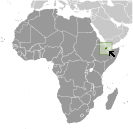World Atlas: Djibouti. On this page you can see the map, country flag and many detailed information about the people, history and economy of Djibouti.

Here you can find online selected information about the geography, inhabitants, government, economy and history of Djibouti. Included are selected statistics, an overview map and the detailed map of Djibouti. But let's start with the flag of Djibouti here:
Djibouti - Overview:
What you should know about Djibouti? Let's start with this: The French Territory of the Afars and the Issas became Djibouti in 1977. Hassan Gouled Aptidon installed an authoritarian one-party state and proceeded to serve as president until 1999. Unrest among the Afar minority during the 1990s led to a civil war that ended in 2001 with a peace accord between Afar rebels and the Somali Issa-dominated government. In 1999, Djibouti's first multiparty presidential election resulted in the election of Ismail Omar Guelleh as president; he was reelected to a second term in 2005 and extended his tenure in office via a constitutional amendment, which allowed him to serve a third term in 2011 and begin a fourth term in 2016. Djibouti occupies a strategic geographic location at the intersection of the Red Sea and the Gulf of Aden and serves as an important shipping portal for goods entering and leaving the east African highlands and transshipments between Europe, the Middle East, and Asia. The government holds longstanding ties to France, which maintains a significant military presence in the country, and has strong ties with the US. Djibouti hosts several thousand members of US armed services at US-run Camp Lemonnier.
Geography of Djibouti
 Where on the globe is Djibouti? The location of this country is Eastern Africa, bordering the Gulf of Aden and the Red Sea, between Eritrea and Somalia. Total area of Djibouti is 23,200 sq km, of which 23,180 sq km is land. So this is not a large country. How could we describe the terrain of the country? This way: coastal plain and plateau separated by central mountains. The lowest point of Djibouti is Lac Assal -155 m, the highest point Moussa Ali 2,021 m. And the climate is desert; torrid, dry.
Where on the globe is Djibouti? The location of this country is Eastern Africa, bordering the Gulf of Aden and the Red Sea, between Eritrea and Somalia. Total area of Djibouti is 23,200 sq km, of which 23,180 sq km is land. So this is not a large country. How could we describe the terrain of the country? This way: coastal plain and plateau separated by central mountains. The lowest point of Djibouti is Lac Assal -155 m, the highest point Moussa Ali 2,021 m. And the climate is desert; torrid, dry.
Inhabitants of Djibouti
Let's take a look how many people live in Djibouti. The number is: 865,267 (July 2017 est.). So not so many people live here. Who lives here? Somali 60%, Afar 35%, other 5% (includes French, Arab, Ethiopian, and Italian). What are the languages in Djibouti? French (official), Arabic (official), Somali, Afa. And the religions: Muslim 94%, Christian 6%. How old are the people in average? 23.9 years. We have to add that this number is the median - so one half of the people is older than this, one half is younger. And what is their life expectancy (at birth)? This: 63.6 years. Where the people live in Djibouti? Here: most densely populated areas are in the east; the largest city is Djibouti, with a population over 600,000; no other city in the country has a total population over 50,000. The major urban areas of Djibouti are: Djibouti (capital) 529,000 (2015).
Government and Economy of Djibouti
The capital of Djibouti is Djibouti and the government type semi-presidential republic. Let's take a look at the administrative divisions - 6 districts (cercles, singular - cercle); Ali Sabieh, Arta, Dikhil, Djibouti, Obock, Tadjourah. Regarding the economy of Djibouti, important industrial products are construction, agricultural processing, shipping. Important agricultural products are fruits, vegetables; goats, sheep, camels, animal hides. The most important export commodities are reexports, hides and skins, coffee (in transit), scrap metal and the most important export partners are Ethiopia 39%, Somalia 17.8%, Qatar 9.4%, Brazil 9.1%, Yemen 5.1% (2016). The most important import commodities are foods, beverages, transport equipment, chemicals, petroleum products, clothing and the most important import partners are UAE 25.8%, France 16.4%, China 10.4%, Saudi Arabia 8.4%, Ethiopia 7%, Yemen 4.8% (2016). How rich is Djibouti and how rich are people in this country? The most important number here is GDP per capita (PPP): $3,600 (2017 est.). This is a very low number. Let's add that this means Gross Domestic Product per person, which is recalculated with respect to the relative cost of local goods and services. And one more important number - population below poverty line: 23%.